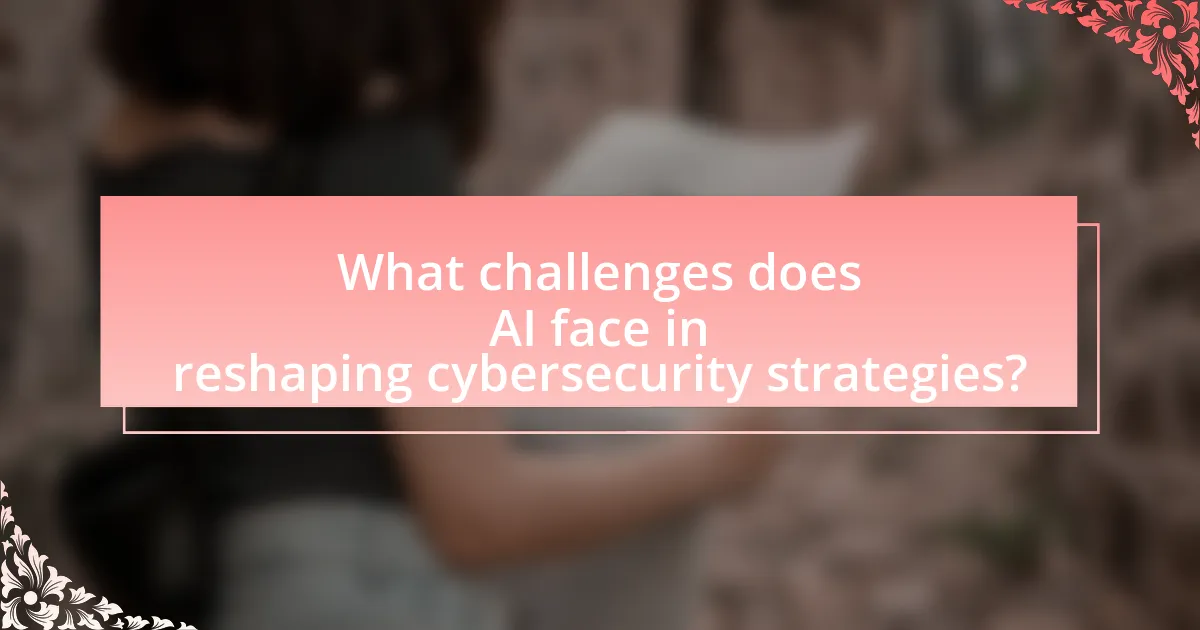The article focuses on how artificial intelligence (AI) is reshaping cybersecurity strategies by enhancing threat detection and response capabilities through advanced machine learning algorithms. It discusses key AI technologies such as machine learning, natural language processing, and behavioral analytics that improve the effectiveness of cybersecurity measures. The article also addresses the challenges and ethical concerns associated with AI in cybersecurity, including data privacy and algorithmic bias. Furthermore, it outlines best practices for organizations to implement AI tools effectively, emphasizing the importance of continuous monitoring and human oversight in enhancing cybersecurity frameworks.

How is AI transforming the landscape of cybersecurity strategies?
AI is transforming the landscape of cybersecurity strategies by enhancing threat detection and response capabilities through advanced machine learning algorithms. These algorithms analyze vast amounts of data in real-time, identifying patterns and anomalies that indicate potential security breaches. For instance, a report by McKinsey highlights that AI can reduce the time to detect a breach from weeks to minutes, significantly improving incident response times. Additionally, AI-driven tools automate repetitive tasks, allowing cybersecurity professionals to focus on more complex threats, thereby increasing overall efficiency and effectiveness in safeguarding digital assets.
What are the key AI technologies influencing cybersecurity?
Key AI technologies influencing cybersecurity include machine learning, natural language processing, and behavioral analytics. Machine learning algorithms analyze vast amounts of data to identify patterns and detect anomalies, enabling proactive threat detection. Natural language processing enhances the ability to analyze and interpret unstructured data, such as security logs and threat intelligence reports, improving incident response. Behavioral analytics monitors user and entity behavior to establish baselines and identify deviations that may indicate security breaches. These technologies collectively enhance the effectiveness of cybersecurity measures by automating threat detection and response, thereby reducing response times and improving overall security posture.
How do machine learning algorithms enhance threat detection?
Machine learning algorithms enhance threat detection by analyzing vast amounts of data to identify patterns and anomalies indicative of potential security threats. These algorithms can process and learn from historical data, allowing them to recognize unusual behavior that may signify a cyber attack. For instance, a study by IBM found that organizations using machine learning for threat detection can reduce the time to identify and respond to incidents by up to 90%. This capability enables proactive defense mechanisms, as machine learning models continuously adapt to new threats, improving their accuracy and effectiveness over time.
What role does natural language processing play in cybersecurity?
Natural language processing (NLP) plays a crucial role in cybersecurity by enhancing threat detection and response capabilities. NLP algorithms analyze vast amounts of textual data, such as emails, logs, and social media, to identify potential security threats, phishing attempts, and malicious content. For instance, a study by IBM found that NLP can improve the accuracy of threat detection systems by up to 90% by enabling them to understand context and intent in communications. This capability allows cybersecurity teams to respond more effectively to incidents, reducing the time to mitigate threats and improving overall security posture.
Why is AI becoming essential in modern cybersecurity frameworks?
AI is becoming essential in modern cybersecurity frameworks due to its ability to analyze vast amounts of data quickly and identify patterns indicative of cyber threats. Traditional cybersecurity methods often struggle to keep pace with the increasing volume and sophistication of attacks, whereas AI can enhance threat detection and response times significantly. For instance, a report by McKinsey & Company highlights that organizations using AI-driven security solutions can reduce incident response times by up to 90%. This capability allows for proactive measures against potential breaches, making AI a critical component in safeguarding digital assets.
How does AI improve response times to cyber threats?
AI improves response times to cyber threats by automating threat detection and response processes. This automation allows security systems to analyze vast amounts of data in real-time, identifying anomalies and potential threats much faster than human analysts. For instance, AI algorithms can process network traffic and user behavior patterns to detect unusual activities within seconds, significantly reducing the time it takes to respond to incidents. According to a report by IBM, organizations using AI in their cybersecurity strategies can reduce the time to identify and contain a breach by up to 27% compared to those relying solely on manual processes. This efficiency not only enhances the speed of response but also minimizes potential damage from cyber attacks.
What advantages does AI offer over traditional cybersecurity methods?
AI offers several advantages over traditional cybersecurity methods, primarily through enhanced threat detection and response capabilities. AI systems can analyze vast amounts of data in real-time, identifying patterns and anomalies that may indicate a security breach, which traditional methods often miss due to their reliance on predefined rules and signatures. For instance, a study by IBM found that organizations using AI for cybersecurity can reduce the time to detect and respond to threats by up to 90%. Additionally, AI can adapt and learn from new threats, continuously improving its defenses, while traditional methods typically require manual updates and adjustments. This adaptability is crucial in an evolving threat landscape, making AI a more effective solution for modern cybersecurity challenges.

What challenges does AI face in reshaping cybersecurity strategies?
AI faces significant challenges in reshaping cybersecurity strategies, primarily due to issues related to data privacy, algorithmic bias, and the evolving nature of cyber threats. Data privacy concerns arise as AI systems require vast amounts of data to learn and adapt, which can lead to potential breaches of sensitive information. Algorithmic bias can result in AI systems making flawed decisions based on skewed training data, potentially overlooking critical threats. Additionally, the dynamic landscape of cyber threats means that AI must continuously evolve to keep pace with sophisticated attack methods, which can strain resources and complicate implementation. These challenges highlight the need for robust frameworks and ethical guidelines to ensure effective and secure AI integration in cybersecurity.
What are the ethical concerns surrounding AI in cybersecurity?
The ethical concerns surrounding AI in cybersecurity include issues of privacy, bias, accountability, and the potential for misuse. Privacy concerns arise as AI systems often require access to vast amounts of personal data to function effectively, which can lead to unauthorized surveillance or data breaches. Bias in AI algorithms can result in discriminatory practices, as these systems may inadvertently favor certain groups over others based on flawed training data. Accountability is another significant concern, as it can be unclear who is responsible for decisions made by AI systems, especially in cases of errors or breaches. Furthermore, the potential for misuse of AI technologies by malicious actors raises alarms about the escalation of cyber threats, as AI can be employed to automate attacks or create sophisticated phishing schemes. These concerns highlight the need for ethical guidelines and regulatory frameworks to govern the use of AI in cybersecurity.
How can bias in AI algorithms affect cybersecurity outcomes?
Bias in AI algorithms can lead to significant vulnerabilities in cybersecurity outcomes by misclassifying threats and prioritizing certain types of data over others. When AI systems are trained on biased datasets, they may overlook or misinterpret malicious activities that do not fit the predefined patterns, resulting in undetected breaches or false positives. For instance, a study by MIT found that facial recognition systems exhibited higher error rates for individuals with darker skin tones, which can translate into biased security measures that disproportionately target specific demographics. This misalignment can compromise the effectiveness of threat detection and response strategies, ultimately weakening an organization’s cybersecurity posture.
What measures can be taken to ensure ethical AI use in cybersecurity?
To ensure ethical AI use in cybersecurity, organizations should implement robust governance frameworks that include transparency, accountability, and fairness in AI algorithms. Establishing clear guidelines for data usage, ensuring that AI systems are trained on diverse datasets to avoid bias, and conducting regular audits of AI systems can help maintain ethical standards. For instance, the European Union’s General Data Protection Regulation (GDPR) emphasizes the importance of data protection and privacy, which can serve as a model for ethical AI practices in cybersecurity. Additionally, involving multidisciplinary teams in the development and deployment of AI systems can enhance ethical considerations by incorporating various perspectives and expertise.
How do organizations address the limitations of AI in cybersecurity?
Organizations address the limitations of AI in cybersecurity by implementing a multi-layered security approach that combines human expertise with AI capabilities. This strategy involves integrating AI tools with traditional security measures, such as firewalls and intrusion detection systems, to enhance threat detection and response. For instance, according to a report by McKinsey & Company, organizations that combine AI with human oversight can improve their incident response times by up to 50%. Additionally, continuous training and updating of AI models with new threat data are essential to ensure their effectiveness, as highlighted in research by the Ponemon Institute, which found that 70% of organizations that regularly update their AI systems report better security outcomes. By fostering collaboration between AI technologies and cybersecurity professionals, organizations can effectively mitigate the risks associated with AI limitations.
What strategies can enhance AI’s effectiveness in threat detection?
Implementing continuous learning algorithms enhances AI’s effectiveness in threat detection by allowing systems to adapt to evolving threats. Continuous learning enables AI models to update their knowledge base in real-time, improving their ability to identify new patterns and anomalies associated with cyber threats. For instance, a study by MIT researchers found that machine learning models that continuously learn from new data can reduce false positives by up to 30%, thereby increasing the accuracy of threat detection systems. Additionally, integrating multi-layered security approaches, such as combining machine learning with traditional rule-based systems, further strengthens AI’s capability to detect complex threats, as evidenced by the success of hybrid models in various cybersecurity applications.
How can human oversight complement AI in cybersecurity operations?
Human oversight can complement AI in cybersecurity operations by providing critical contextual understanding and ethical judgment that AI lacks. While AI excels at processing vast amounts of data and identifying patterns, human experts can interpret these findings, assess the implications, and make informed decisions based on nuanced understanding of the organizational context. For instance, a study by IBM found that organizations employing a combination of AI and human analysts experienced a 30% reduction in response time to security incidents, demonstrating the effectiveness of this collaborative approach.

What future trends can we expect in AI-driven cybersecurity strategies?
Future trends in AI-driven cybersecurity strategies include increased automation, enhanced threat detection, and improved incident response capabilities. Automation will streamline security processes, allowing organizations to respond to threats in real-time without human intervention. Enhanced threat detection will leverage machine learning algorithms to identify anomalies and potential threats more accurately, reducing false positives. Improved incident response capabilities will utilize AI to analyze past incidents and predict future attacks, enabling proactive measures. According to a report by Gartner, by 2025, 60% of organizations will use AI-driven security solutions, highlighting the growing reliance on AI in cybersecurity.
How will AI evolve to meet emerging cybersecurity threats?
AI will evolve to meet emerging cybersecurity threats by enhancing its predictive capabilities and automating threat detection and response. As cyber threats become more sophisticated, AI systems will leverage machine learning algorithms to analyze vast amounts of data in real-time, identifying patterns and anomalies indicative of potential attacks. For instance, according to a report by McKinsey, organizations using AI for cybersecurity can reduce incident response times by up to 90%. This evolution will also include the integration of AI with other technologies, such as blockchain, to create more secure systems. Furthermore, AI will adapt through continuous learning from new threats, improving its accuracy and effectiveness in mitigating risks.
What advancements in AI technology are on the horizon for cybersecurity?
Advancements in AI technology on the horizon for cybersecurity include enhanced threat detection through machine learning algorithms, automated incident response systems, and predictive analytics for identifying vulnerabilities. Machine learning algorithms are increasingly capable of analyzing vast amounts of data in real-time, allowing for the identification of anomalies that may indicate a cyber threat. Automated incident response systems are being developed to react to threats without human intervention, significantly reducing response times. Predictive analytics will leverage historical data to forecast potential security breaches, enabling organizations to proactively strengthen their defenses. These advancements are supported by ongoing research and development in AI, which aims to improve the accuracy and efficiency of cybersecurity measures.
How will the integration of AI and IoT impact cybersecurity strategies?
The integration of AI and IoT will significantly enhance cybersecurity strategies by enabling real-time threat detection and automated response mechanisms. AI algorithms can analyze vast amounts of data generated by IoT devices to identify anomalies and potential security breaches more efficiently than traditional methods. For instance, a report by McKinsey & Company highlights that AI can reduce the time to detect a breach from months to minutes, thereby minimizing potential damage. Additionally, the combination of AI’s predictive capabilities with IoT’s extensive network of connected devices allows for proactive security measures, such as automated patch management and vulnerability assessments, which are crucial in an increasingly complex threat landscape.
What best practices should organizations adopt for AI in cybersecurity?
Organizations should adopt best practices such as continuous monitoring, data privacy compliance, and integrating AI with human expertise for effective cybersecurity. Continuous monitoring enables real-time threat detection and response, which is crucial given that cyber threats evolve rapidly. Data privacy compliance ensures that AI systems adhere to regulations like GDPR, protecting sensitive information and maintaining user trust. Integrating AI with human expertise leverages the strengths of both technology and human intuition, enhancing decision-making processes in threat assessment and incident response. These practices are supported by studies showing that organizations employing AI-driven cybersecurity solutions experience a 30% reduction in breach incidents compared to those relying solely on traditional methods.
How can businesses effectively implement AI tools in their cybersecurity frameworks?
Businesses can effectively implement AI tools in their cybersecurity frameworks by integrating machine learning algorithms for threat detection and response automation. This integration allows for real-time analysis of network traffic and user behavior, significantly enhancing the ability to identify anomalies indicative of cyber threats. For instance, a study by McKinsey & Company found that organizations using AI for cybersecurity can reduce incident response times by up to 90%. Additionally, businesses should prioritize continuous training of AI models with updated threat intelligence to adapt to evolving cyber threats, ensuring that the AI systems remain effective over time.
What training is necessary for cybersecurity professionals to leverage AI effectively?
Cybersecurity professionals need training in machine learning, data analysis, and AI ethics to leverage AI effectively. This training equips them with the skills to understand AI algorithms, analyze large datasets for threat detection, and ensure ethical considerations in AI deployment. For instance, a report by the World Economic Forum highlights that 60% of organizations believe AI will significantly enhance their cybersecurity capabilities, emphasizing the need for professionals to be proficient in these areas to adapt to evolving threats.


